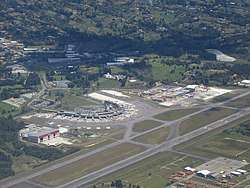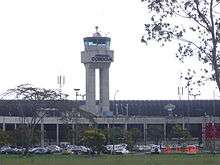José María Córdova International Airport
| José María Córdova International Airport Aeropuerto Internacional José María Córdova | |||||||||||
|---|---|---|---|---|---|---|---|---|---|---|---|
 | |||||||||||
| Summary | |||||||||||
| Airport type | Commercial | ||||||||||
| Operator | AirPlan | ||||||||||
| Serves | Medellín Metropolitan Area | ||||||||||
| Location | Rionegro | ||||||||||
| Hub for | Avianca Cargo and Viva Colombia | ||||||||||
| Elevation AMSL | 7,027 ft / 2,142 m | ||||||||||
| Coordinates | 06°10′02″N 75°25′36″W / 6.16722°N 75.42667°W | ||||||||||
| Website | Official Web | ||||||||||
| Map | |||||||||||
 MDE Location of airport in Colombia | |||||||||||
| Runways | |||||||||||
| |||||||||||
| Statistics (2017) | |||||||||||
| |||||||||||
|
Sources: Grupo Aeroportuario del Sureste SkyVector[1] | |||||||||||
José María Córdova International Airport (IATA: MDE, ICAO: SKRG) is the second largest airport in Colombia after El Dorado International Airport of Bogotá in terms of infrastructure and passenger service. It is located in the city of Rionegro, 20 kilometres (12 mi) south-east of Medellín.
It is the most important airport in the Antioquia Department, and in terms of infrastructure, it is the most important in western Colombia. It's also the main hub for low-cost airline Viva Colombia. It serves several international destinations, one of the busiest being the route to Miami International Airport. It also serves the most flown route within Colombia: Rionegro-Bogota, which is mainly operated by Avianca, Copa Airlines Colombia, Viva Colombia and LATAM Colombia. In recent years, significant technology and infrastructure upgrades (like LCD screen signage) have been made, making it one of the most recognized airports in Colombia. It now has service to destinations in Europe and has added new destinations in South and Central America, and in the Caribbean.
International destinations include the United States, Panama, Costa Rica, El Salvador, Venezuela, Ecuador, Peru, Mexico, Curaçao and Spain. The airport also serves domestic flights to most major Colombian cities such as Bogota, Cali, Barranquilla, Cartagena, Santa Marta and San Andres Island. Freight transport is also one of the strengths of the terminal, providing air transportation to most of the flower exports (and other products) from eastern Antioquia bound to South, Central and North America, and Europe.
Since its inauguration in 1985 until 1990, the terminal had heavy passenger and cargo movement, in part because the Olaya Herrera Airport, located in the center of Medellín, was closed during this time. When it reopened, traffic reduced. Since 1993, however, there has been a steady increase in traffic as well as an increase in the number of airlines flying into the airport, including American Airlines, LATAM, TACA, Aerogal. As for cargo airlines, Martinair, Centurion Air Cargo, ABSA, and Florida West International Airways and national freight airlines such as Tampa Cargo, LANCO, AeroSucre have increased their flights to the terminal.The airport is currently undergoing a comprehensive renovation.
Description
The airport serves all major international and domestic routes in contrast to Olaya Herrera Airport, which serves the Medellín area with regional flights only. José María Córdova is set for a major expansion that will include new international terminals and an expansion of the cargo terminal. This is set to start next year according to the Special Administrative Unit of Civil Aeronautics. The airport is named after José María Córdova (sometimes spelled "Córdoba"), a Colombian army general who was a native of Ríonegro.
The José María Córdova International Airport is the second in Colombia in total passenger and cargo also in international and national after the El Dorado International Airport in Bogota. The runway is also used by the nearby military base in the Air Force of Colombia located in Rionegro, named Air Combat Command No. 5 (CACOM 5), where all types of military and national police aircraft arrive and depart.
The airport has air navigation aids such as VOR, NDB, and ILS, which allow greater ease of operation for pilots making navigation and landings safer in bad weather.[2][3][4]
In January 2006, an Airbus A380 landed at the air terminal (first time on Colombian soil) to conduct technical tests of the engines.
Antioquia's exports, mostly flowers and other products from the region, depart en route to international destinations from these terminals. The cargo operator TAMPA has its main base at the airport, and operates flights to countries in South, Central and North America. Tampa cargo has a ramp that can accommodate up to ten aircraft. All types of aircraft, including Boeing 747, Douglas DC-10, Boeing 767 are among the most common arrivals at the terminal. In addition, the terminal is near the customs area and airline hangars Tampa Cargo.
The airport has three restaurants and a shopping area, where there are banks, ATM's, money exchange, and car rentals. The airline Avianca also has a VIP room inside the facility serving domestic and international flights. Outside the main building is a parking lot with a capacity for 250 cars and an area for motorcycles. Long term parking is also provided. You can arrive to your final destination in a variety of manners such as taxis which you can rent for yourself or share with other passengers, and buses known as "collectivos."
In 2016, the airport handled 7,376,160 passengers, and 6,892,104 in 2017.
History
Between 1930 and 1932, three wealthy families in the metropolitan area of Medellín began with the idea of providing the city with an airport, as they were part of the Colombian Air Navigation Company which sought to carry passengers and mail from the city of Medellín to Puerto Berrio, along the Magdalena River and ultimately connect the cities of Medellín and Bogotá. One of the most important was Gonzalo Mejia, who in a very colloquial manner determined what would be the only place where an airport could be built; this location was later confirmed by the Curtis Wright firm based in New York City.
After several obstacles, the city of Medellín finally apporoved the construction of an unpaved runway about 974 m long, which would later become Enrique Olaya Herrera Airport. Companies like Saco and Scadta from the cities of Barranquilla and Bogotá soon began service. Then in the 70s the need for a larger airport for the province of Antioquia arose due to saturation and limitations of the Olaya Herrera Airport. Two sites were proposed for the new airport: one in the vicinity of the municipality of Barbosa northeast of the city, and another in the valley of San Nicolas in Rionegro, east of the city. The latter was selected and construction was begun.
The airport opened in 1985. During the same year, Avianca conducted test flights of its Boeing 747, first on the original runway at Olaya Herrera Airport, and then at the new José María Córdova. During this time the airport had significant movement of cargo and passengers, as the operations from the Olaya Herrera airport declined to almost zero (both airports today have traffic, but the Olaya Herrera airport only serves for domestic flights).(José María Córdova is now the main airport for cargo and international flights from Medellín).
Modernization

José María Córdova Airport anticipates that the modernization plan, which includes various infrastructure projects, will make this an airport terminal as attractive for tourists as for airlines.
Within the works, passengers will find security systems, flight information via digital displays, high-tech communication, passenger arrival lounges with shopping, improvement in health services, improvement in firefighting services, and improvement in baggage handling systems.
The objectives of the modernization and expansion plan are to ensure aviation safety and comfort of passengers and their companions, and to meet the requirements of ICAO, AEROCIVIL (the Colombian civil aviation authority) and IATA.
The transformation of José María Córdova International Airport also seeks to contribute to the country's competitiveness through the creation of spaces that enable optimal connectivity with other cities in the world, the development of new areas that are attractive to airlines, the creation of zones that favor the encounter of citizens and compliance with new policies of quality for passengers to enjoy the best service at time of travel.
Airlines and destinations
Passenger
| Airlines | Destinations |
|---|---|
| Aeroméxico | Mexico City |
| Aeroméxico Connect | Seasonal: Cancún (begins November 17, 2018)[5] |
| Air Panama | Panama City–Albrook |
| American Airlines | Miami |
| Avianca | Barranquilla, Bogotá, Bucaramanga, Cali, Cartagena, Cúcuta, Madrid, Miami, Montería, New York–JFK, San Andres Island, Santa Marta |
| Avianca El Salvador | San Salvador |
| Avianca Peru | Lima |
| Avior Airlines | Valencia (VE), Caracas |
| Copa Airlines Colombia | Panama City |
| Iberia | Madrid |
| JetBlue Airways | Fort Lauderdale |
| LATAM Colombia | Bogotá, Cartagena, San Andrés Island, Santa Marta |
| LATAM Perú | Lima |
| Spirit Airlines | Fort Lauderdale, Orlando (begins November 9, 2018)[6] |
| Viva Colombia | Barranquilla, Bogotá, Cartagena, Miami, Monteria, Panama City-Balboa, San Andres Island, Santa Marta |
| Wingo | Panama City-Balboa |
Cargo airlines
Statistics
| Rank | City | Passengers | Top carriers |
|---|---|---|---|
| 1 | Bogotá, Cundinamarca | 3,590,548 | Avianca, LATAM Colombia, Viva Colombia |
| 2 | Cali, Valle del Cauca | 739,954 | Avianca, Viva Colombia |
| 3 | Cartagena, Bolívar | 735,408 | Avianca, Viva Colombia, LATAM Colombia |
| 4 | Barranquilla, Atlántico | 365,086 | Avianca, Viva Colombia |
| 5 | San Andrés, San Andrés | 329,274 | LATAM Colombia, Viva Colombia |
| 6 | Santa Marta, Magdalena | 276,684 | Avianca, Viva Colombia |
| 7 | Montería, Córdoba | 125,534 | Avianca, Viva Colombia |
| 8 | Bucaramanga, Santander | 65,888 | Avianca |
| Rank | City | Passengers | Top carriers |
|---|---|---|---|
| 1 | 386,499 | Copa Airlines Colombia | |
| 2 | 249,167 | American Airlines, Avianca, Viva Colombia | |
| 3 | 172,929 | JetBlue Airways, Spirit Airlines | |
| 4 | 85,894 | Avianca, Iberia | |
| 5 | 63,614 | Avianca El Salvador | |
| 6 | 63,475 | Avianca | |
| 7 | 63,276 | Avianca Perú | |
| 8 | 62,774 | Aeromexico | |
| 9 | 56,857 | Delta Air Lines | |
| 10 | 53,809 | Viva Colombia, Wingo | |
| 11 | 46,873 | Air Panama | |
| 12 | 40,174 | Avior Airlines | |
| 13 | 13,995 | Insel Air | |
| 14 | 6,082 | Insel Air Aruba |
See also
References
- ↑ "Jose Maria Cordova Airport". SkyVector. Retrieved 3 August 2018.
- ↑ Medellin NDB
- ↑ Marinilla VOR
- ↑ Rionegro VOR
- ↑ "Aeroméxico announces flight between Cancún and Medellín" (in Spanish). EnElAire. July 2018. Retrieved July 24, 2018.
- ↑ "Spirit Airlines Announces Major International Expansion". Spirit Airlines. June 2018. Retrieved June 14, 2018.
- ↑ Aerocivil statistics
- ↑ Aerocivil traffic
External links
| Wikimedia Commons has media related to José María Córdova International Airport. |
- Accident history for José María Córdova International Airport at Aviation Safety Network
- Airplan - Website (in Spanish)
- OpenStreetMap - José María Córdova International Airport
- Current weather for Rionegro, Colombia at NOAA/NWS
- Airport information for José María Córdova International Airport at Great Circle Mapper.